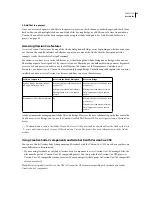
FLASH CS3
User Guide
72
You can use the
_root
alias to refer to the main Timeline of the current level. For the main Timeline, the
_root
alias
stands for
_level0
when targeted by a movie clip also on
_level0
. For a document loaded into
_level5
,
_root
is
equal to
_level5
when targeted by a movie clip also on level 5. For example, if the movie clips
southcarolina
and
florida
are both loaded into the same level, an action called from the instance
southcarolina
could use the
following absolute path to target the instance
florida
:
_root.eastCoast.florida
About relative paths
A relative path depends on the relationship between the controlling Timeline and the target Timeline. Relative paths
can address targets only within their own level of Flash Player. For example, you can’t use a relative path in an action
on
_level0
that targets a Timeline on
_level5
.
In a relative path, use the keyword
this
to refer to the current Timeline in the current level; use the
_parent
alias
to indicate the parent Timeline of the current Timeline. You can use the
_parent
alias repeatedly to go up one level
in the movie clip hierarchy within the same level of Flash Player. For example,
_parent._parent
controls a movie
clip up two levels in the hierarchy. The topmost Timeline at any level in Flash Player is the only Timeline with a
_parent
value that is undefined.
An action in the Timeline of the instance
charleston
, located one level below
southcarolina
, could use the
following target path to target the instance
southcarolina
:
_parent
To target the instance
eastCoast
(one level up) from an action in
charleston
, you could use the following relative path:
_parent._parent
To target the instance
atlanta
from an action in the Timeline of
charleston
, you could use the following relative path:
_parent._parent.georgia.atlanta
Relative paths are useful for reusing scripts. For example, you could attach the following script to a movie clip that
magnifies its parent by 150%:
onClipEvent (load) {_parent._xscale = 150;_parent._yscale = 150;
}
You can reuse this script by attaching it to any movie clip instance.
Note:
Flash Lite 1.0 and 1.1 support attaching scripts only to buttons. Attaching scripts to movie clips is not supported.
Whether you use an absolute or a relative path, you identify a variable in a Timeline or a property of an object with
a dot (
.
) followed by the name of the variable or property. For example, the following statement sets the variable
name
in the instance
form
to the value
"Gilbert"
:
_root.form.name = "Gilbert";
Using absolute and relative target paths
You can use ActionScript to send messages from one timeline to another. The timeline that contains the action is
called the
controlling timeline
, and the timeline that receives the action is called the
target timeline
. For example, there
could be an action on the last frame of one timeline that tells another timeline to play. To refer to a target timeline,
you must use a target path, which indicates the location of a movie clip in the display list.
The following example shows the hierarchy of a document named westCoast on level 0, which contains three movie
clips:
california
,
oregon
, and
washington
. Each of these movie clips in turn contains two movie clips.
















































